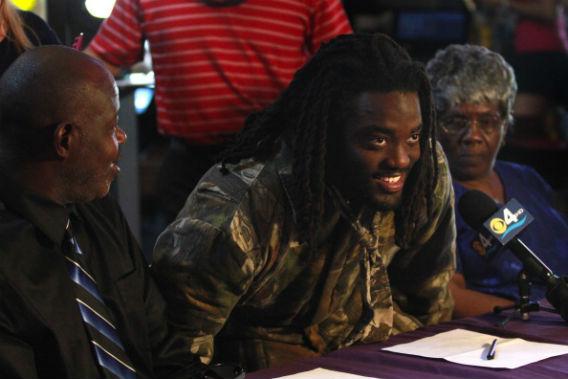Top college football prospect Alex Collins spent Wednesday trying to track down his mother, who had intercepted his letter of intent to attend the University of Arkansas. (Apparently she did not want him to attend college far from home.) Colleges cannot accept commitments from players under 21 without the signature of a parent or guardian. Eventually Collins’ father signed the form, but aren’t 18-year-olds legally entitled to make their own decisions?
Yes and no. The legal age of majority in most states is 18. Reaching that milestone gives you the right to enter into legally binding contracts. If an 18-year-old signs an employment agreement and reneges, the jilted employer can collect damages. Employers do not, however, have to enter into a contract with an 18-year-old just because he has reached the age of majority, nor must they treat all adults exactly the same. The Age Discrimination in Employment Act prohibits discrimination only on the basis of old age. Discriminating against young people is legal under federal law, and most states have similar statutes.
There is a significant exception. The New Jersey Supreme Court in 1999 allowed a former bank vice president to bring an age discrimination suit against his employers, who fired him shortly after finding out he was only 25 years old. Even in New Jersey, though, the chance of successfully challenging the parental consent requirement for collegiate letters of intent would be low. First, neither the NCAA nor college athletic departments technically employ student athletes. In addition, courts have generally allowed special treatment of young people, especially in an attempt to protect their interests. You can’t drink until you’re 21, even though you’re legally an adult, nor can you buy a handgun from a dealer. Most states allow car rental companies to refuse service to people under 21 or 25. New York forces companies to rent to all adults but allows them to charge young people significant fees. The U.S. Supreme Court in 1971 invalidated an NBA rule requiring players to wait four years after high school graduation to join the league, but that decision was based on anti-trust law—the league imposed the rule on the players unilaterally. The NBA’s current rule, setting a minimum age of 19, was negotiated with the players’ union and is unlikely to be struck down.
Colleges sometimes go to great lengths to obtain a parent’s or guardian’s signature on a letter of intent. They track parents down in developing countries, visit them in prison, and occasionally have to ask for a waiver when a parent is completely unavailable.
There’s some irony to the parental consent demand for letters of intent: The NCAA applies no such requirement to other contracts. New student-athletes must, for example, sign NCAA Form 08-3a in order to participate in sports. The agreement releases the student’s academic records and grants the NCAA the right to use his or her likeness in promotional materials. If a player is under the age of 18, and thus legally incapable of signing a binding contract, the parent or guardian must sign. But the same 18-,19-, and 20-year-olds who need parental consent to commit to a school are entitled to sign away their promotional rights on their own.
Form 08-3a has recently become a serious legal issue. Former UCLA basketball star Ed O’Bannon, joined by such former collegiate luminaries as Oscar Robertson and Bill Russell, has sued the NCAA, claiming that the organization has no right to use their likenesses in video games without obtaining the players’ permission or compensating them. O’Bannon argues that Form 08-3a is unenforceable because the NCAA gives players no choice but to sign.
Got a question about today’s news? Ask the Explainer.
Explainer thanks Michael Dorf of Cornell University Law School, Christine Jolls of Yale Law School, and Joanna Lahey of Texas A&M University.
